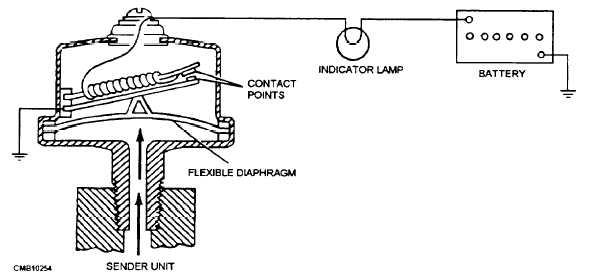2. The bypass system (fig. 6-25) diverts only a small quantity of oil each time it is circulated and returns it directly to the oil pan after it is filtered. This type of system does not filter the oil before it is sent to the engine. The oil from the main oil gallery enters the filter and flows through the filter element. It then passes into the collector in the center of the filter. The filtered oil then flows out a restricted outlet preventing the loss of pressure. The oil then returns directly to the oil pan.
Oil Galleries
Oil galleries are small passages through the cylinder block and head for lubricating oil. They are cast or machined passages that allow oil to flow to the engine bearing and other moving parts.
The main oil galleries are large passages through the center of the block They feed oil to the crankshaft bearings, camshaft bearings, and lifters. The main oil galleries also feed oil to smaller passages running up to the cylinder heads.
Oil Pressure Warning Light
The oil pressure warning light (fig. 6-26) is used in place of a gauge on many vehicles. The warning light, although not as accurate, is valuable because of its high visibility in the event of a low oil pressure condition. Because the engine can fail or be damaged in less than a minute of operation without oil pressure, the warning light is used as a backup for a gauge to attract instant attention to a malfunction.
The warning light receives battery power through the ignition switch. The circuit to ground is completed through the oil pressure-sending unit that screws into the engine and is exposed to one of the oil galleries. The sending unit consists of a pressure-sensitive diaphragm that operates a set of contact points. The contact points are calibrated to turn on the warning light anytime oil pressure drops below approximately 15 psi in most vehicles.
When oil pressure is low, the spring in the sending unit holds a pair of contacts closed. This action completes the circuit and the indicator light glows. When oil pressure is normal, oil pressure acts on a diaphragm in the sending unit. Diaphragm deflection opens the contact points to break the circuit. This action causes the warning light to go out, informing the operator of good pressure.
Oil Pressure Gauge
The oil pressure gauge is mounted on the instrument panel of a vehicle. Marked off on a dial in pounds per square inch (psi), the gauge indicates how regularly and evenly the oil is being delivered to all vital parts of the engine and warns of any stoppages in this delivery. Pressure gauges may be electrical or mechanical.
In the mechanical type, the gauge on the instrument panel is connected to an oil line tapped into an oil gallery leading from the pump. The pressure of the oil in the system acts on a diaphragm within the gauge, causing the needle to register on the dial. In the electrical type, oil pressure operates a rheostat connected to the engine that signals electrically

Figure 6-26. - Oil pressure warning light.
Continue Reading